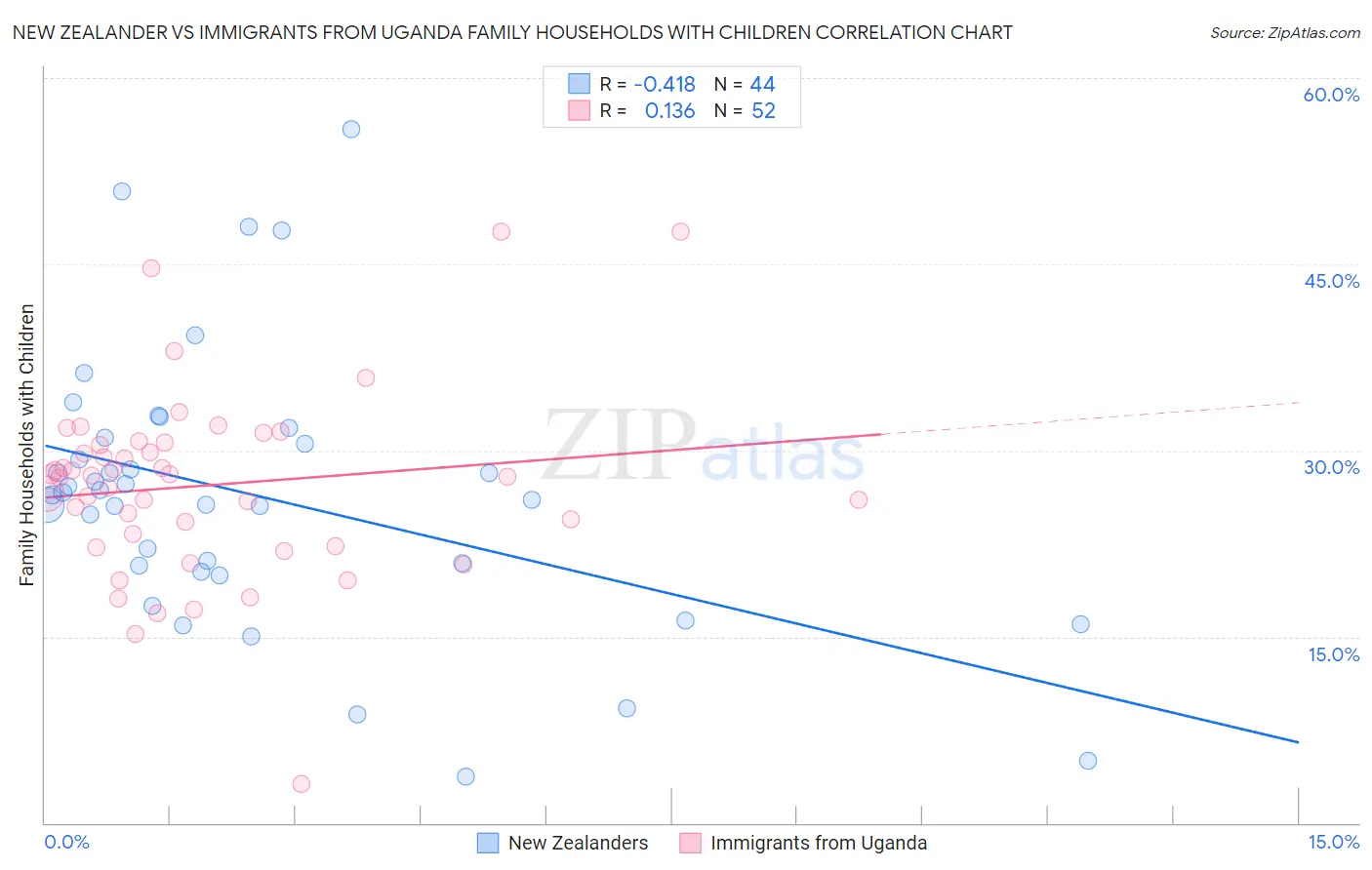New Zealander vs Immigrants from Uganda Family Households with Children
COMPARE
New Zealander
Immigrants from Uganda
Family Households with Children
Family Households with Children Comparison
New Zealanders
Immigrants from Uganda
27.1%
FAMILY HOUSEHOLDS WITH CHILDREN
9.6/ 100
METRIC RATING
221st/ 347
METRIC RANK
28.0%
FAMILY HOUSEHOLDS WITH CHILDREN
97.7/ 100
METRIC RATING
107th/ 347
METRIC RANK
New Zealander vs Immigrants from Uganda Family Households with Children Correlation Chart
The statistical analysis conducted on geographies consisting of 106,880,294 people shows a moderate negative correlation between the proportion of New Zealanders and percentage of family households with children in the United States with a correlation coefficient (R) of -0.418 and weighted average of 27.1%. Similarly, the statistical analysis conducted on geographies consisting of 125,961,015 people shows a poor positive correlation between the proportion of Immigrants from Uganda and percentage of family households with children in the United States with a correlation coefficient (R) of 0.136 and weighted average of 28.0%, a difference of 3.3%.

Family Households with Children Correlation Summary
| Measurement | New Zealander | Immigrants from Uganda |
| Minimum | 3.8% | 3.2% |
| Maximum | 55.8% | 47.7% |
| Range | 52.1% | 44.5% |
| Mean | 26.4% | 27.2% |
| Median | 26.6% | 28.0% |
| Interquartile 25% (IQ1) | 20.4% | 22.7% |
| Interquartile 75% (IQ3) | 30.8% | 30.5% |
| Interquartile Range (IQR) | 10.3% | 7.8% |
| Standard Deviation (Sample) | 11.0% | 7.6% |
| Standard Deviation (Population) | 10.8% | 7.5% |
Similar Demographics by Family Households with Children
Demographics Similar to New Zealanders by Family Households with Children
In terms of family households with children, the demographic groups most similar to New Zealanders are Paraguayan (27.1%, a difference of 0.010%), Austrian (27.1%, a difference of 0.020%), Pima (27.1%, a difference of 0.030%), German (27.1%, a difference of 0.060%), and Immigrants from Japan (27.1%, a difference of 0.070%).
| Demographics | Rating | Rank | Family Households with Children |
| Africans | 13.0 /100 | #214 | Poor 27.2% |
| Northern Europeans | 12.8 /100 | #215 | Poor 27.2% |
| Cubans | 12.2 /100 | #216 | Poor 27.1% |
| U.S. Virgin Islanders | 12.1 /100 | #217 | Poor 27.1% |
| Greeks | 11.4 /100 | #218 | Poor 27.1% |
| Immigrants | Japan | 10.7 /100 | #219 | Poor 27.1% |
| Austrians | 9.9 /100 | #220 | Tragic 27.1% |
| New Zealanders | 9.6 /100 | #221 | Tragic 27.1% |
| Paraguayans | 9.4 /100 | #222 | Tragic 27.1% |
| Pima | 9.2 /100 | #223 | Tragic 27.1% |
| Germans | 8.7 /100 | #224 | Tragic 27.1% |
| Canadians | 7.5 /100 | #225 | Tragic 27.1% |
| Czechoslovakians | 6.6 /100 | #226 | Tragic 27.0% |
| Tsimshian | 6.6 /100 | #227 | Tragic 27.0% |
| Scottish | 6.5 /100 | #228 | Tragic 27.0% |
Demographics Similar to Immigrants from Uganda by Family Households with Children
In terms of family households with children, the demographic groups most similar to Immigrants from Uganda are Immigrants from Burma/Myanmar (28.0%, a difference of 0.010%), Tohono O'odham (28.0%, a difference of 0.020%), Immigrants from South America (28.0%, a difference of 0.060%), Spaniard (28.0%, a difference of 0.060%), and Scandinavian (28.0%, a difference of 0.12%).
| Demographics | Rating | Rank | Family Households with Children |
| Indonesians | 98.8 /100 | #100 | Exceptional 28.1% |
| Immigrants | Oceania | 98.8 /100 | #101 | Exceptional 28.1% |
| Assyrians/Chaldeans/Syriacs | 98.7 /100 | #102 | Exceptional 28.1% |
| Palestinians | 98.5 /100 | #103 | Exceptional 28.1% |
| Sioux | 98.3 /100 | #104 | Exceptional 28.1% |
| Choctaw | 98.3 /100 | #105 | Exceptional 28.1% |
| Immigrants | South America | 98.0 /100 | #106 | Exceptional 28.0% |
| Immigrants | Uganda | 97.7 /100 | #107 | Exceptional 28.0% |
| Immigrants | Burma/Myanmar | 97.7 /100 | #108 | Exceptional 28.0% |
| Tohono O'odham | 97.6 /100 | #109 | Exceptional 28.0% |
| Spaniards | 97.4 /100 | #110 | Exceptional 28.0% |
| Scandinavians | 97.1 /100 | #111 | Exceptional 28.0% |
| Immigrants | Middle Africa | 97.0 /100 | #112 | Exceptional 28.0% |
| Arabs | 97.0 /100 | #113 | Exceptional 28.0% |
| South American Indians | 96.9 /100 | #114 | Exceptional 28.0% |